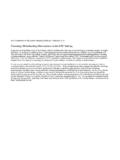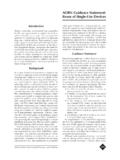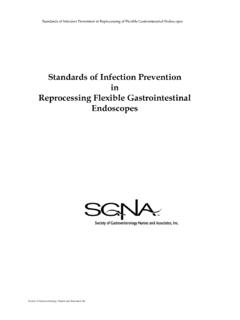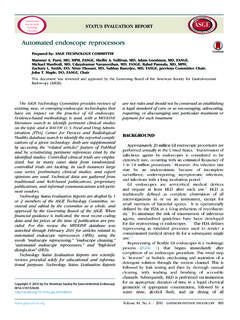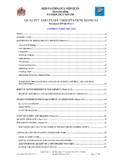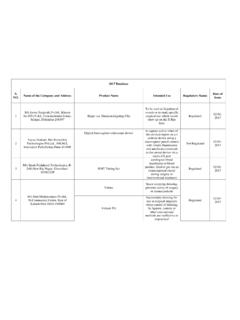Transcription of STANDARDS FOR INFECTION CONTROL AND …
1 STANDARDS of INFECTION CONTROL in reprocessing of flexible gastrointestinal endoscopes STANDARDS of INFECTION CONTROL in reprocessing of flexible gastrointestinal endoscopes STANDARDS of INFECTION CONTROL in reprocessing of flexible gastrointestinal endoscopes 2 Acknowledgements Copyright 2012, Society of Gastroenterology Nurses and Associates, Inc. (SGNA). First published in 1996, revised 2000, 2005, 2007, 2008, 2012. This document was prepared and written by the members of SGNA Practice Committee and adopted by the SGNA Board of Directors in 2012. It is published as a service to SGNA members.
2 SGNA Practice Committee 2011 12 Michelle E. Day MSN BSN RN CGRN Chair Michelle Juan MSN ACNS-BC RN CGRN Co Chair Kathy Buffington BSN RN CGRN Rhonda L. Casey RN BS MHA CGRN Cynthia M. Friis MEd BSN RN-BC Ann Herrin, BSN RN CGRN Colleen Kelley Keith MSN RN CGRN Judy Lindsay MA BSN RN CGRN Marilee Schmelzer PhD RN Barbara Zuccala MSN RN CGRN Reprints are available for purchase from SGNA Headquarters. To order, contact: Department of Membership Services Society of Gastroenterology Nurses and Associates, Inc. 401 N. Michigan Avenue Chicago, IL 60611-4267 Tel: (800) 245-SGNA or (312) 321-5165 Fax: (312) 673-6694 Online: Email: Disclaimer The Society of Gastroenterology Nurses and Associates, Inc.
3 Present this guideline for use in developing institutional policies, procedures, and/or protocols. Information contained in this guideline is based on current published data and current practice at the time of publication. The Society of Gastroenterology Nurses and Associates, Inc. assume no responsibility for the practices or recommendations of any member or other practitioner, or for the policies and practices of any practice setting. Nurses and associates function within the limits of state licensure, state nurse practice act, and/or institutional policy. STANDARDS of INFECTION CONTROL in reprocessing of flexible gastrointestinal endoscopes Table of Contents Education & Quality Procedure reprocessing Spill Containment INFECTION CONTROL Endoscope reprocessing STANDARDS of INFECTION CONTROL in reprocessing of flexible gastrointestinal endoscopes Preface These STANDARDS are presented by the Society of Gastroenterology Nurses and Associates, Inc.
4 (SGNA) to be used for all settings where gastrointestinal endoscopy is practiced. These STANDARDS have been developed to complement the position statement, reprocessing of flexible gastrointestinal endoscopes -An American Society for gastrointestinal Endoscopy White Paper (Walter, 1996) and developed by the American Society for gastrointestinal Endoscopy (ASGE), Association for Professionals in INFECTION CONTROL and Epidemiology (APIC), and SGNA. The current version complements SGNA's (2009) Guideline for the Use of High Level Disinfectants and Sterilants for reprocessing of flexible gastrointestinal endoscopes . Proper reprocessing of endoscopes and accessories is critical to the safe and successful treatment of patients (American Society for gastrointestinal Endoscopy [ASGE], 2008).
5 The SGNA and ASGE support increased research in the areas of endoscope design and encourage manufacturers to develop flexible gastrointestinal endoscopes that can be easily disassembled for reprocessing and verification of cleaning and high level disinfection. The use of non-immersible endoscopes is no longer acceptable because endoscopes that cannot be completely immersed in liquid cannot be adequately cleaned and high-level disinfected (Rutala & Weber, 2004). endoscopes reprocessed appropriately in accordance with reprocessing and INFECTION CONTROL guidelines pose virtually no risk of transmission of patient-borne or environmental microorganisms.
6 In the absence of defective equipment, every reported case of hospital acquired INFECTION associated with a contaminated gastrointestinal (GI) endoscope has been linked to a breech or violation of at least one of several requisite reprocessing steps (ASGE, 2008; American Society for gastrointestinal Endoscopy Quality Assurance in Endoscopy Committee et al., 2011). The United States Food and Drug Administration (FDA) has approved labeling for some automated endoscope reprocessors. The labeling clears these machines as washer-disinfectors which do not require prior manual cleaning and channel brushing. However, bedside pre-cleaning is still required.
7 While the introduction of automated, brushless washing of endoscope channels represents a potentially significant advancement, the existing multi-society guideline (American Society for gastrointestinal Endoscopy Quality Assurance in Endoscopy Committee et al., 2011) and other international STANDARDS emphasize the importance of manual cleaning and brushing for the overall efficacy of high level disinfection (HLD). The redundancy achieved by adding an automated washing step following manual cleaning can undoubtedly provide an extra level of safety. Users are cautioned about dispensing with manual cleaning endoscope reprocessing and brushing steps before the capabilities of the new machines are confirmed in independent studies and in clinical practice (Alfa, Olson, & DeGagne, 2006; ASGE, 2008).
8 Diligence in application of all steps of reprocessing remains paramount in the safe delivery of endoscopic services. STANDARDS of INFECTION CONTROL in reprocessing of flexible gastrointestinal endoscopes Definitions For the purpose of this document, SGNA adopted the following definitions: Anionic detergent: A type of surfactant (see surfactant definition below). Automated endoscope reprocessor (AER) refers to machines designed for the purpose of cleaning and disinfecting endoscopes and accessories. Meticulous manual cleaning must precede the use of AERs (American Society for gastrointestinal Endoscopy Quality Assurance in Endoscopy Committee et al.)
9 , 2011). Biofilm refers to a matrix of different types of bacteria and extracellular material that can tightly adhere to the interior surfaces of endoscopes (Association for the Advancement of Medical Instrumentation [AAMI], 2010; Miner, Harris, Ebron, & Cao, 2007). Endoscope refers a tubular instrument used to examine the interior of the hollow viscera. In this document, endoscope refers only to flexible gastrointestinal endoscopes . Enzymatic detergent refers to low-foaming detergents which add enzymes capable of digesting organic material such as blood and mucous. High-level disinfectant refers to a chemical germicide that has been cleared by the FDA as capable of destroying all viruses, vegetative bacteria, fungi, mycobacterium and some, but not all, bacterial spores (Rutala, 1996).
10 High-level disinfection (HLD) refers to the destruction of all microorganisms with the exception of low levels of bacterial spores (Rutala, Weber, & the Healthcare INFECTION CONTROL Practices Advisory Committee [HICPAC], 2008). Material Safety Data Sheet (MSDS) refers to a descriptive sheet that accompanies a chemical or chemical mixture and provides information regarding the identity of the material; physical hazards, such as flammability; and acute and chronic health hazards associated with contact with or exposure to the compound. Minimum effective concentration (MEC) refers to the lowest concentration of active ingredient necessary to meet the label claim of a reusable high-level disinfectant/sterilant (AAMI, 2010).


